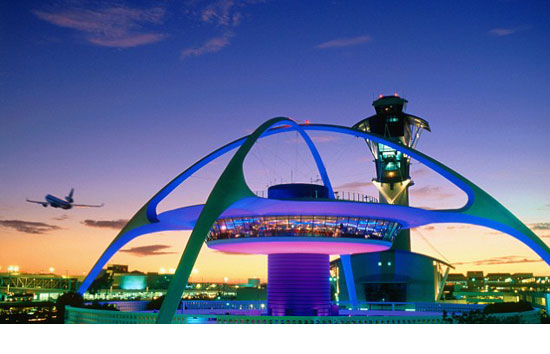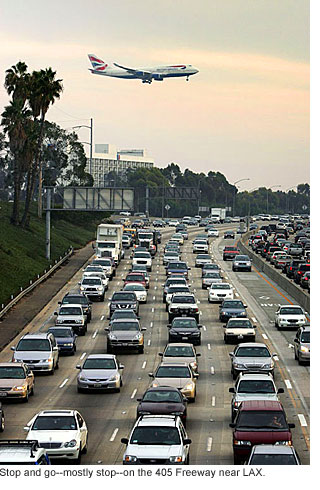A closure heard ’round the world
June 6, 2011
 In most big cities, a detour is just a detour. Not in a world capital like Los Angeles.
In most big cities, a detour is just a detour. Not in a world capital like Los Angeles.
When a 10-mile stretch of one of the nation’s busiest freeways shuts down next month for a full weekend at the height of the summer tourist season, it won’t be enough for the locals to know that the 405 Freeway will be temporarily closed just north of Los Angeles International Airport. Travelers from around the globe will also have to be made aware that the freeway will be cerrará. And fermée. And geschlossen, 被 闭, and 폐쇄.
To that end, officials from LAX, Metro, Caltrans and other local organizations have created one of the world’s biggest phone trees to spread the word about the 53-hour closure that will start before midnight on Friday, July 15, and continue through the pre-dawn hours of Monday, July 18. The shut down through the Sepulveda Pass has been ordered as a safety precaution during demolition of the Mulholland Bridge, part of a massive freeway-widening project. (Full details are here.)
Notices of the closure are going out in eight languages via TV, print, radio, web and social media, and are expected to be further translated as they ricochet around the planet. A separate flyer is being prepared for airlines to forward to individual ticket holders.
The Los Angeles Convention and Visitors Bureau is alerting some 180,000 travel professionals, ticket brokers, hotels, restaurants, travel writers and individual tourists about the shut down via targeted newsletters, says spokesman Michael McDowell. Another 600,000 or so of the bureau’s Facebook friends and Twitter followers will also get the memo.
And for those who still manage to land here without knowing about the closure, LAX is preparing to call in extra troops of volunteer passenger information assistants to beef up the 13 information booths at the airport.
“Our goal is to ensure that passengers coming in and out plan ahead,” says Nancy Castles, public relations director for LAX, which is expected to see more than 170,500 travelers per day during that weekend, including some 52,500 international tourists.
About 40% of these travelers will connect to other flights. And many of those remaining in the region will likely rely on cabbies, shuttle operators, local friends or relatives who by then will hopefully know to use detours, says Castles. But for others, she adds, delays and unfamiliarity with L.A. will be a serious source of frustration.
“If we take the traffic analysts at their word, the 405 will have gridlock for 28 miles north of the 101 and 24 miles south of the 10 if they don’t get 70% of the cars off the freeway that would normally drive it on a summer weekend,” she says. “And if everyone is trying to go east or west on the Santa Monica Freeway, that’s going to back up beyond downtown L.A.”
Heading that off is a big job, Castles concedes, but not nearly as big as it was during the 1984 Olympics, when logistical bulletins had to be gotten out without the benefit of text messaging, social media and the Internet.
“Time is on our side and, this time, technology is on our side,” Castles says.
Julie Valentine, director of corporate services in the Los Angeles office of the travel agency Altour, says the firm is aware that “traffic is going to be hellish.” But Altour’s booking system, she says, allows the agency to notify clients directly and offer alternative booking times if their travel dates are flexible.
The Los Angeles visitors bureau, meanwhile, already has issued advisories to its offices in the U.K., Germany, Japan, Korea, Australia, China and Miami, which serves the Americas. The organization also has a special link on its website to the 405 closure.
Looking on the bright side, bureau spokesman McDowell says the closure actually is well-timed because “happily there are no major conventions on those days and we’re not aware of any significantly large tour groups. But we are getting the word out to the tour operators to avoid the 405.”
His group is recommending tour destinations during the closure that can be reached through Metro’s transit system, such as Downtown L.A., Hollywood and Universal Studios. The visitor’s bureau also is working with hotels throughout the region, particularly those popular with international travelers, including the Luxe Hotel Sunset Boulevard and the Hotel Angeleno, both of which are within the affected area of the 405.
Reginald Archambault, general manager at the Luxe, says reservation clerks are advising guests of the closure in advance. But so far, he says, those fair warnings haven’t put a dent in bookings. “This is just one segment of a long project,” he says, “so I don’t think people are completely surprised.”
L.A.’s first line of tourism ambassadors—airport cabbies and limo drivers—seem less sanguine about how all this will unfold. Will Hebler, senior director of sales and marketing for Yellow Cab of Los Angeles, says that while fares out of LAX shouldn’t be as impacted as those in the areas around Brentwood and Mulholland, “it’s going to affect dispatchers because they’re going to have to find ways from Point A to Point C.”
Elton Silva, owner-operator of a small limo company based in Willowbrook, says that although much of his business is airport-based, he hopes to avoid the 405 altogether that weekend.
“It’s not going to be worth it,” he says. “We do a lot of fixed-rate business, and this means we’ll have to spend a bunch of hours and waste a lot of time and gas sitting in traffic. And it’s going to be hard to find a shortcut because everybody will be looking for the same thing.”
Officials at SuperShuttle, meanwhile, say they’re meeting this week to map alternative routes to popular destinations. (As a side note, they’re reassuring travelers that the more circuitous routes will not mean higher SuperShuttle fares.)
Of course, one option would be for travelers to choose airports other than LAX. Castles says local tourism officials won’t be suggesting that. But they are asking everyone to be prepared.
“We want people to know they need to allot plenty of time once they get here,” says Castles. “Don’t plan to land at 1 p.m. on a Sunday and be on your cruise ship by three, even if that’s what you’re used to. If you’re coming in domestically and thinking, ‘Well, I only need 90 minutes or whatever to get to that wedding’, allow more time than you normally would. Don’t cut it close.”
Posted 6/2/11












 405 bridge work causes a stink
405 bridge work causes a stink

